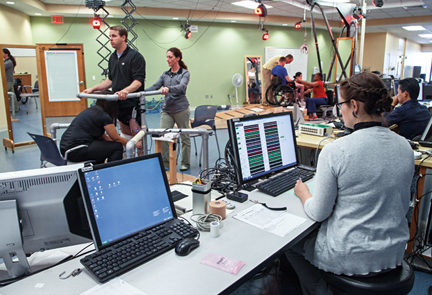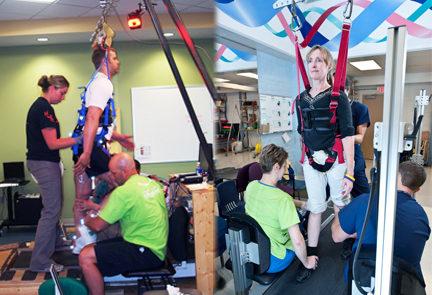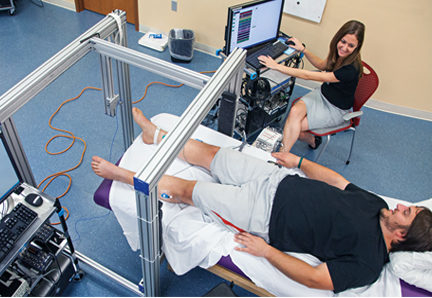Paralyzed Man Shows Remarkable Recovery
 |
|
Five years ago, Rob Summers was 20 years old and about to enter his junior year at Oregon State University in Corvallis, where he was a pitcher on the baseball team. One night when he went out to retrieve a gym bag from his car, another car jumped the curb, hit him, and then took off. Summers was paralyzed from the chest down. Today, in a case report published in The Lancet, doctors and researchers reveal that Summers has regained the ability to stand for a few minutes and to perform some voluntary movements of his lower extremities, thanks to electrodes they implanted in his spinal cord.
|
Miracle of Paralysed Crash Victim Who Can Walk Again
 |
A hit-and-run victim paralysed from the waist down has stood up on his own and taken his first steps after pioneering treatment. Rob Summers, 25, is the first patient to respond to the therapy, which involves electrical stimulation of the spinal cord. He said: ‘This procedure has completely changed my life.’
|
Epidural Stimulator Implant Surgery
 |
|
14th Implant
|
University of Louisville Researchers Report Activity-based Training Improves Urinary Function After Spinal Cord Injury
 |
Spinal cord injury impacts communication between the brain and the neurons in the lower part of the spinal cord that controls bladder, bowel, and sexual function. This communication from the brain is necessary for voluntarily control of these systems. Investigators from the Kentucky Spinal Cord Injury Research Center at the University of Louisville have discovered that rehabilitation designed to improve motor function also resulted in improved bladder, bowel and sexual desire. Their work, which is published in the journal PLOS ONE, highlights the value of activity-based rehabilitative therapies, such as locomotor training, for not only improving motor activity, but also for the potential to recover autonomic function throughout the body.
|
Clinical Trial for Epidural Stimulation Approved
 |
WDRB story on epidural stimulation research at U of L including interviews with Rob Summers, Stefanie Putnam, and Susan Harkema.
|
Paralyzed Man Shocks Scientists Be Regaining the Ability to Stand and Move On His Own
 |
A research participant at the University of Louisville with a complete spinal cord injury, who had lost motor function below the level of the injury, has regained the ability to move his legs voluntarily and stand six years after his injury. A study published today in Scientific Reports describes the recovery of motor function in a research participant who previously had received long-term activity-based training along with spinal cord epidural stimulation. This wonderful and exciting news is being reported around the world. Check below for some of the coverage of this groundbreaking development in the understanding and treatment of spinal cord injuries.
|
New $5M Grant to Support Robotics Research for Spinal Cord Injury Patients
 |
Balance is an essential component of daily life, something many of us take for granted. But not everyone can. In the United States alone, there are about 300,000 people living with spinal cord injury (SCI) and some 12,000 new SCI cases each year, most of them young adults, 80% of them men. The recovery of motor functions—walking, standing, and balance—after a SCI is slow and limited, can be highly variable, and can take months or even years. The cost of care for SCI patients is enormous—annually over $3 billion. Studies have shown, however, that activity-based interventions offer a promising approach, and Sunil Agrawal, professor of mechanical engineering and of rehabilitation and regenerative medicine at Columbia Engineering, is at the forefront of research efforts to improve recovery through the development of novel robotic devices and interfaces that help patients retrain their movements.
|
Paralyzed Groom Defies the Odds, Stands at Wedding
 |
Several wedding guests dried their tears as Kent Stephenson patiently stood, waiting for his bride to come down the aisle. Some of that emotion was surely for Misti Richeson, walking down the aisle in her lacy white dress and cowboy boots, but many others were astonished at what Stephenson was able to do, standing at the altar. Stephenson and Richeson had only been dating for a few months when Stephenson, a Pro Am Motocross racer, had a devastating accident. In June 2009, the motor on his motorcycle locked up 80 feet in the air. The crash injured his spinal cord and left his body paralyzed from the chest down. Doctors said he’d be in a wheelchair the rest of his life.
|
#GivingExpress: NextStep Fitness: Gym Inspires Hope in the Paralyzed
 |
Morning Express’ sports correspondent Brian McFayden is passionate about all things sports and fitness, so it’s only natural that Brian selected NextStep Fitness as his charity for #GivingExpress. NextStep Fitness in Lawndale, California, is a non-profit organization that founder Janne Kouri says provides a ‘progressive, state-of-the art, community based fitness, health, and wellness facility for people that are living with paralysis.’ NextStep Fitness utilizes a method of rehabilitation therapy called locomotor training. Locomotor training uses a treadmill and suspends a person above it. Then, therapists move the person’s legs in a stepping and walking motion, trying to retrain the spinal cord how to walk again. “A lot of people do regain function. Some people get to walking again…the health benefits of locomotor training are just unbelievable,” says Kouri.
|
CNN: Paralyzed Patients Able to Stand
 |
“I can stand up for more than half an hour,” said Dustin Shillcox, who was paralyzed in a car accident five years ago. “It’s awesome. It’s amazing. It’s a hopeful feeling.” Shillcox and the other three men had electrical stimulators surgically implanted in their spines, and are working toward walking again someday.
|
|
Epidural Stimulation Program
Epidural Stimulation Timeline
Motor Control
Cardiovascular and Respiratory
Bladder, Bowel and Sexual Function
Publications – Epidural Stimulation |













